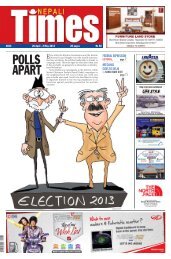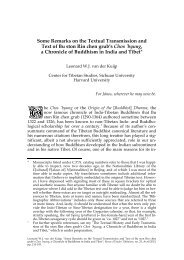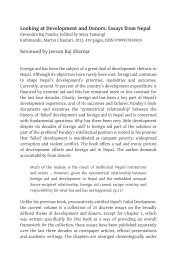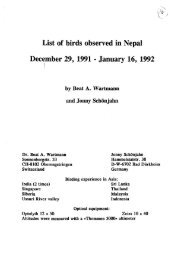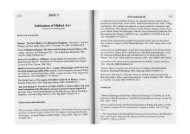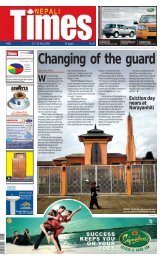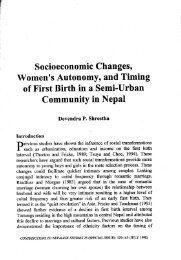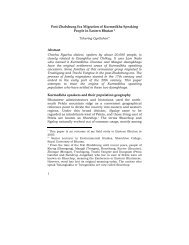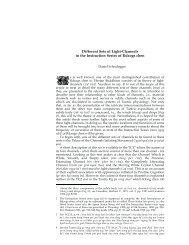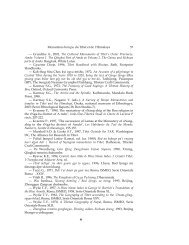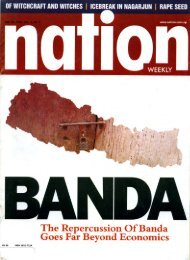• RNA Gheraoes Maoists • Vajpayee-Musharraf ... - Digital Himalaya
• RNA Gheraoes Maoists • Vajpayee-Musharraf ... - Digital Himalaya
• RNA Gheraoes Maoists • Vajpayee-Musharraf ... - Digital Himalaya
Create successful ePaper yourself
Turn your PDF publications into a flip-book with our unique Google optimized e-Paper software.
NATIONAL<br />
Among South Asian nations the<br />
Maldives , Sri Lanka, India, Pakistan,<br />
Nepal, Bhutan and Bangladesh rank 77th,<br />
8lst, I 15th, 127th, 129th, 130thand 132nd<br />
respectively.<br />
According to the Human Development<br />
index, Nepal ranks ahead of Bhutan<br />
and Bangladesh in the region. Nepal's life<br />
expectancy is 58.1 at birth, adult literacy<br />
rate is 40.4 percent, combined primary,<br />
secondary and tertiary gross enrolment<br />
ratio is 60 percent, GDP per capita (PPP<br />
US$) 1237, life expectancy index is 0.55,<br />
education index is 0.47, GDP index is<br />
0.42. If the country succeeds in increasing<br />
lale life expectancy, female literacy<br />
and total literacy, its situalion may dramatically<br />
change for the better.<br />
One can sce inequality in income and<br />
consumption, as there is growing disparities<br />
of haves and have-not. "Despite so<br />
many hindrances and complications. we<br />
have been able to achieve some progress<br />
in various areas," said Prith vi Raj Liga J,<br />
vice-chairman of the National Planning<br />
Commission. "Had the situation<br />
remain peace ful , the<br />
country 's wou ld have been<br />
in a much better position .<br />
Our aim now should be to<br />
X<br />
ID<br />
move the status from low -g<br />
human development group c<br />
ID<br />
to medium human develop- !5.<br />
0.8<br />
0.7<br />
0.6<br />
ment," he said. ~ 0.5<br />
Nepal 's population ~<br />
o 0.4<br />
growth is still high. In the :ii<br />
last 25 years, Nepal's popu- § 0.3<br />
HOI Trends in SAARC Countries<br />
1975 - 1999<br />
___ Maldives<br />
--{r- Sri Lanka<br />
~Ind ia<br />
___ Pakistan<br />
___ Nepal<br />
___ Bhutan<br />
- Bangladesh<br />
lation nearly doubled, from I<br />
Note: for M8kjjves and<br />
Bhu1a" data available<br />
13. 1 million in 1975 to 22.5 0.2<br />
!o. 1999 only<br />
1975 1980 1985 1990 1995 1999<br />
million ill 1999. Ferti li t y rate L.. __--"=--"=-"'=--"''''-.--''''''-.-'.::=-______..J<br />
per woman is 4. 8, which is still higher<br />
than other countries of the region. In commitment<br />
to health, access, services and<br />
resources, things are yet to improve satisfactorily.<br />
Only 20 percent of the population<br />
has access to essential drugs and 27<br />
percent of the people are using adequate<br />
sanitation facilities.<br />
The infant mortality rate has decli ned<br />
from 165 per 1,000 in 1970 to just 75.<br />
Highlights From The Report<br />
Human Development in Nepal: Nepal's HDI of 0.480 in 1999 puts the country in<br />
129th position out of 162 countries. Over the last 25 years, Nepal has been steadily<br />
progressing in human development.<br />
Human Poverty Index: Nepal's HP! is 44.2%. In termso[theHPI, Nepal ranks 77th<br />
tout of 90 developing countries<br />
\I,. Gender -Related Development: Nepal's GD! is 0.461, ranki ng it 120th out of<br />
146 countries Nepal is one of the few countries in the world where female life<br />
expectancy is lower than that of males. Only three countries uut of the 146 considered<br />
have lower female literacy rates than Nepal (22.8 percent for women age 15 and above<br />
versus 58 percent for men in Ncpal in 1999)<br />
Progress in Survival: Lifeexpectancy at birth in Nepal in the period 1970-1975 was<br />
43.3 ycars. In 1995-2000, it increased to 57.3 years. The infant mortality (per 1,000<br />
births) decreased from 250 in 1970 to 104 in 1999.<br />
Priorities in Public Spending: Public expenditure on education, as a percentage of<br />
GNP, increased from 2.2 percent in 1985-1987 to 3.2 percent in 1995-1997. Public<br />
expenditure on health, as a percentage of GDP, increased from 0.8 percent in 1990 to<br />
1.3 percent in 1998. While these rates arc comparable to those of Nepal's neighbors,<br />
they are still low.<br />
Technological Achievement: Nepal is ranked 69th out of 72 countries according<br />
to the Technology Achievement Index. This new composite index focuses on creation<br />
of technology, diffusion of reccminnovations, diffusion of old innovations, and human<br />
sk ills. Nepal ranks behind some SAARC neighbors. Sri Lanka is placed 62nd, India,<br />
63rd, and Pakistan, 65th. Bangladesh, Bhutan and Maldives were not ranked.<br />
Nepal's health net has 150 user points around the country, reaching 500 health<br />
professionals and gelling 300 hits a day on its Website.<br />
Nepal's maternal mortality rate, at 540<br />
per 10,000, is still higher compared to<br />
other countries in the region .<br />
Nepal's overall progress was steady<br />
between 1980 and 1990. Had it followed<br />
that pace, the country would have moved<br />
from low human deve lopment to the medium<br />
range. With the restoration of democracy<br />
in 1990 foll owing a violent move·<br />
ment, Nepal's social-sector developmenl<br />
has been destabilized. The country has<br />
faced chronic political instability and an<br />
upsurge in violent activities especially<br />
after 1996.<br />
In the areas of li fe expectancy, infant<br />
mortality and adult literacy.Nepal has made<br />
significant gai n over the last 30 years.<br />
When Nepal embarkcd upon the modernization<br />
process 51 years ago. the country' s<br />
economic and other indicators were abys·<br />
malJy low. Life expectancy was 27 years<br />
and the overall literacy was I percent.<br />
Although progress in the areas of life<br />
expectancy and adult literacy have been<br />
slow. the limited changes the indicators<br />
have brought are nevertheless significant.<br />
"We are planning to introduce moreeffective<br />
and strong programs in the country to<br />
accelerate the process of change in much<br />
faster rate than before:' sa id Minister for<br />
Science and Technolugy Surendra Prasad<br />
Chaudhary.<br />
The message of HDR 200 I - the<br />
theme of which is Making New Technologies<br />
Work for Human Development<br />
- Nepal can make a lot of difference,<br />
provided it succeeds in estab lishine. a stable<br />
political atmosphere and reinforce the<br />
government's commitmen t to social-sec·<br />
tor development.<br />
<strong>•</strong><br />
SPOTLlGHTIJULY 20. 200t<br />
I1




